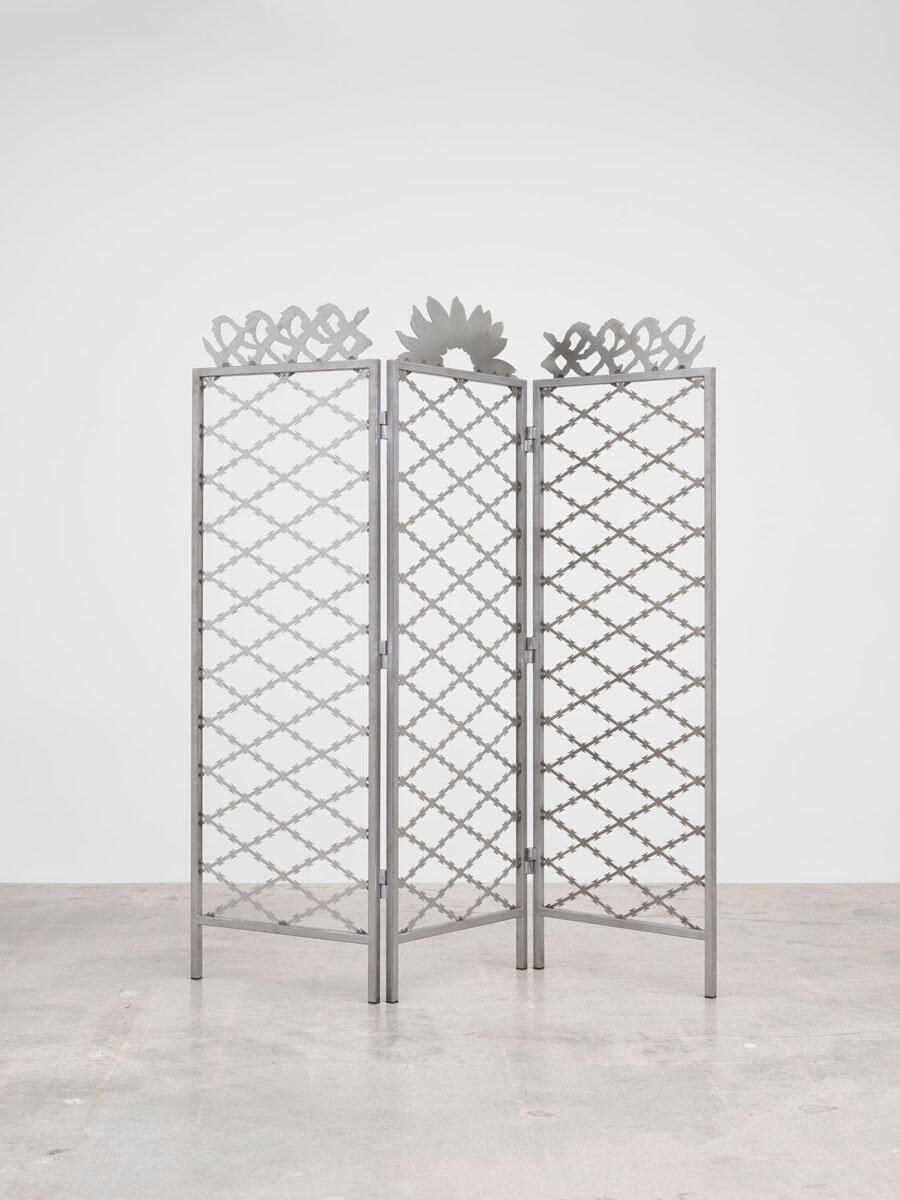Gray Wielebinski’s Americana-Homoerotica
At Anat Ebgi, Los Angeles, sculptures and collages reference modesty screens, BDSM and gay porn mags to index the trans experience
At Anat Ebgi, Los Angeles, sculptures and collages reference modesty screens, BDSM and gay porn mags to index the trans experience

Fear of the monster is actually a kind of desire – so suggests Jeffrey Jerome Cohen’s Monster Culture (1996), a seven-part manifesto indexing the social symbolism and sexual politics of monsters. The monster is a ‘perversely erotic’ taboo-buster, attests Cohen, a conduit to suppressed desires that unlock ‘new spirals’ and ways of perceiving the world. Take the archetypal vampire bite: to go to bed with the monster is to annihilate an old self, to yield to a death drive whose reward is permalife.
Monstrous love is queer, no doubt, but in this hybridization and doubling, this sticky interpenetration of pain and pleasure and twinned processes of death and rebirth, it also indexes the trans experience. In ‘Fratricide’, Gray Wielebinski’s exhibition at Anat Ebgi in Los Angeles, the Dallas-born, London-based artist explores such nested paradoxes through a material toolkit that’s equal parts scrappy and slick, serious and silly. Ornately hostile metal modesty screens, severed arrows twisted up in serpentine BDSM supplies, and frat bro paddles sporting playfully lusty collages of Americana-homoerotica all combine in a slippery field of floating signifiers and multi-layered transmasc meaning-making.

Where to begin with the paddle? A classic pastime of the American military industrial complex, paddling gained popularity in collegiate frat houses post-World War II. The contemporary cancellation of hazing rituals prompted the paddle’s cutesification: it’s now largely confined to the bro-on-bro gift economy. Wielebinski is fixated on such instances of power transfer. Through a practice that tracks predominantly into sculpture and collage, he builds playful scenarios where such ritualized, hypermasculine objects face off against their own deviant histories and morphing meanings

Here, we get a half-dozen paddles (two supersized floor works, four wall-mounted miniatures) collaged with a mixture of images from gay porn mags, bodybuilding competitions and college sports, sourced largely from eBay. In Body Double (2023), a jacked female bodybuilder floats atop a polka dot-covered pin-up boy, hovering inside the void-like cut-out of an Abercrombie & Fitch bag. Reflective duct tape hastily coats the paddle’s handles. The other XL paddle, Fratricide (2023), is equally teeming with imagery. Meanwhile, in There is Still Time, Brother… (2023), Wielebinski takes a different approach: a chaotically clawed-at inferno-red backdrop yields just three images: a sailor’s knot pulled taut, hands on display; two men, twin-like, turned away from the camera; a bodybuilder who sucks in and sticks out their abdomen. In this ambivalent apocalypse, meaning runs rife.

‘There’s a roulette-like process to collage,’ Wielebinski told me, explaining how he draws a link between the messy, crafty nature of the paddle works, and his memories of childhood and queer ways of approaching family dynamics. Significantly, the paddle series was produced in his family home while his partner was recovering from top surgery, a procedure Wielebinski had undertaken a few years prior with the same surgeon. ‘Fratricide integrates psychoanalytic theory with my own personal experience of identity,’ he reflects, ‘but at the time, I also just really felt like I needed to “touch grass” and get my hands dirty.’
Beyond the paddles, ‘Fratricide’ delivers two metallic conundrums: Privacy Screen #2 (2023) and Prerogative (2022). The former, a tri-fold screen laced with barbed wire, collapses notions of domestic modesty into hostile public architecture. The latter, a woven leather whip nursed by a cluster of plated metal arrows, offers the promise of desired pain wrapped up in a kind of paradoxical softness. Nestled deep in the materiality of both works is the idea of power constantly being questioned, subverted and regenerated through the hazy matrix of love. As Monster Culture makes clear, the act of self-annihilation at the claws of the monster is also a demand for more, different, life.
Gray Wielebinski's ‘Fratricide’ is on view at Anat Ebgi Gallery, Los Angeles until 16 December
Main image: Gray Wielebinki, ‘Fratricide’, 2023, installation view. Courtesy: Anat Ebgi Gallery, Los Angeles























